Yokohama Chinatown: Must-Try Foods, Activities and Access from Tokyo

Yokohama Chinatown is the largest Chinatown in Japan and is less than one hour away from Tokyo. With temples, traditional gates, delicious food, and festivals, it is a fun, must-see sightseeing spot. Learn where to go, what to eat, and how to get to Chinatown in Yokohama.
Must-Visit Places and Things to Do in Yokohama Chinatown
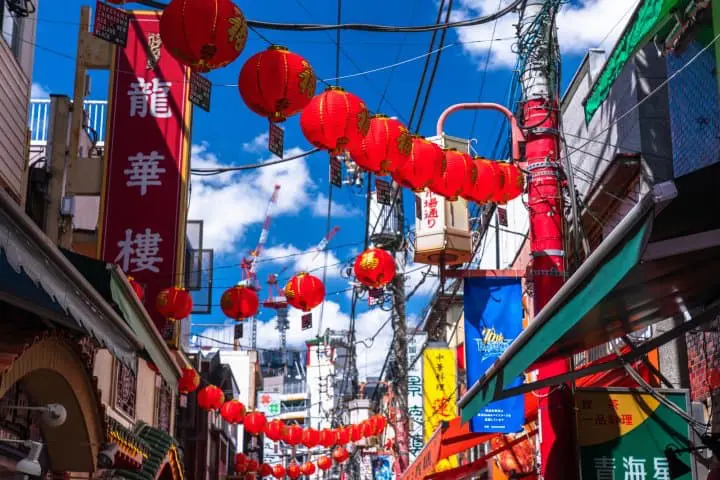
Photo by Pixta
Craving some Chinese cuisine while visiting Japan? Or do you happen to be around Tokyo, looking for your next spot to explore? Then there is no better place for you to visit than the Chinatown in Yokohama, also known as Yokohama Chukagai. It is the largest Chinatown in Japan and a must-visit for its fabulous food, sightseeing, and lively atmosphere. The vibrancy of this area will make you want to visit again and again.
Yokohama Chinatown developed after the port of Yokohama opened to foreign trade in 1859. It became the area of residence to the many Chinese traders who settled down in the city. There are more than 600 Chinese stores and restaurants in the Chinatown today, buzzing with activity from morning until late in the night.
Chinatown in Yokohama is close to the Minato Mirai area, other shopping and sightseeing neighborhoods, and is easily accessible via public transportation on both the JR and Minato Mirai lines. In this article you'll learn about ten must-see places and activities to make the most out of your trip to Chinatown.
Table of Contents:
1. Marvel at the Gorgeous Gates
2. Visit Kanteibyo Temple
3. Visit Yokohama Masobyo
4. Enjoy Delicious Street Food
5. Enjoy Some Fine Peking Duck
6. Dine at All-You-Can Eat and High-End Chinese Restaurants
7. Experience Traditional Chinese Tea
8. Find Traditional Chinese Herbs and Medicines
9. Shop for Chinatown Souvenirs
10. Celebrate Chinese New Year
11. Hotels in Yokohama Chinatown
Access to Yokohama Chinatown
FAQ
Experience the Best of Yokohama Chinatown
1. Marvel at the Gorgeous Gates

Four colorful gates stand at the entrances of Yokohama Chinatown, named after the four directions in Chinese tradition, and five more gates can be found within the colorful neighborhood. You can enter the town from any of the four gates. Guardian deities are enshrined in each of these gates, according to the principles of Feng Shui. It is believed that these deities protect the trade and prosperity of Chinatown.
The East Gate is called Choyo-mon and relates to the Azure Dragon God, and brings prosperity. The South Gate or Suzaku-mon, is associated with Suzaku the sacred Vermillion Bird, and is bright red. It is said to bring good fortune and protection from disaster. The North Gate or Genbu-mon, relates to the Black Tortoise and is associated with the God Xuanwu (in Chinese) or Genbu (in Japanese). Lastly, the West Gate known as Enpei-mon is related to the White Tiger deity of Chinese mythology and is known as Baihu (in Chinese) or Byakko (in Japanese). The gate is supposed to promote eternal peace.
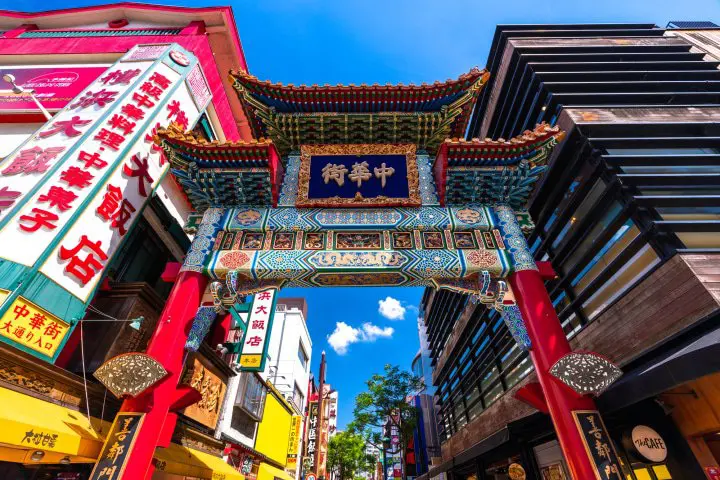
Photo by Pixta
A fifth gate, Zenrin-mon, also known as "The Gate of Good Neighborly Relations" is the symbol of Chinatown and the most beautiful, with its bright and vibrant red color. It symbolizes warm human relationships and the act of welcoming everyone with an open heart.
2. Visit Kanteibyo Temple
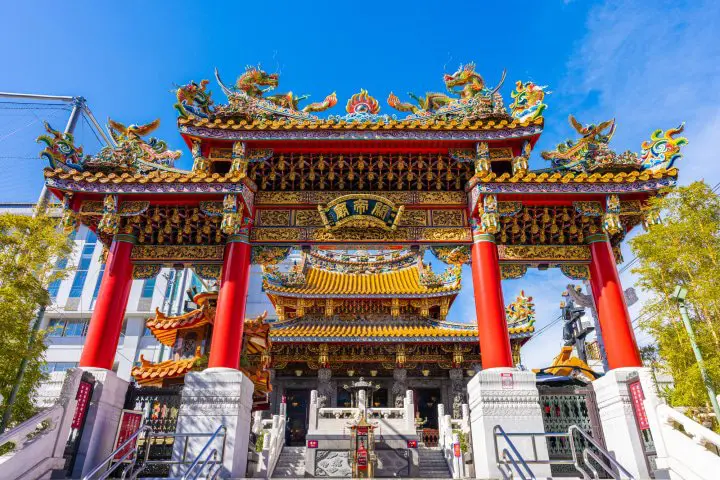
Photo by Pixta
The Kanteibyo is a bright red temple located in the center of Chinatown. Built in 1873 by Chinese residents, it is dedicated to the Chinese deity of good business and prosperity. The temple is so exquisite that people cannot escape its charm. Visitors can offer prayers here and light incense sticks in front of the temple. During the night, the temple is lit up with lanterns.
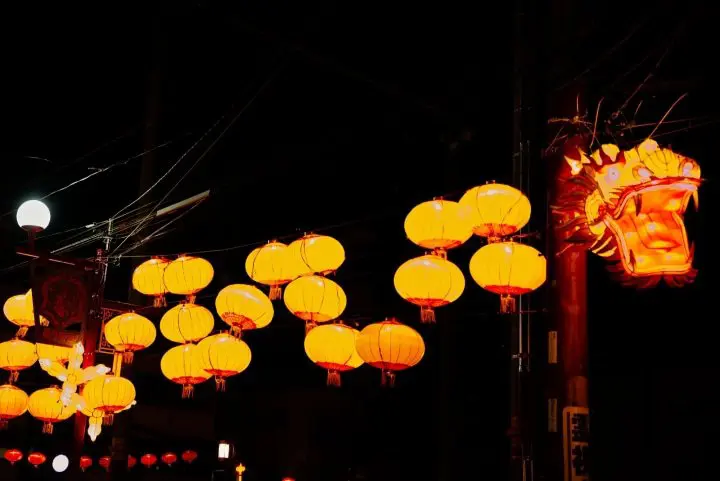
Photo by Pixta
Kanteibyo Temple is elaborately decorated with beautiful and intricate patterns, offering one of the best photographic views in the area.
3. Visit Yokohama Masobyo
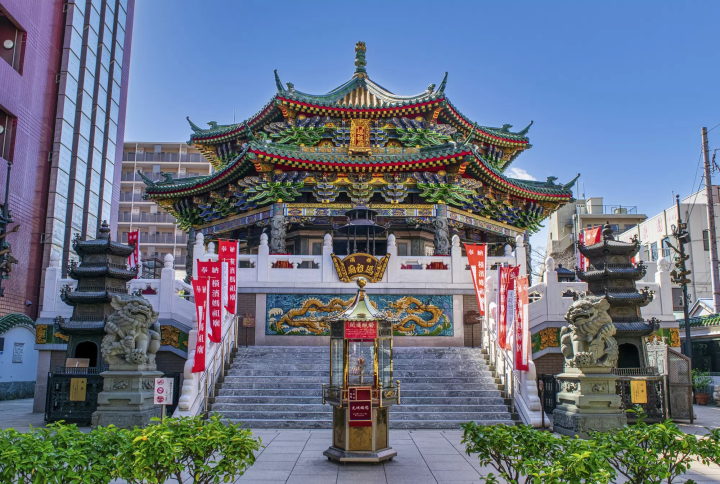
Photo by Pixta
The Yokohama Mazu Temple or Yokohama Masobyo is a facility that was established in 2006 on what is said to be the site of the former Qing Dynasty consulate which had been dedicated to Mazu.
The enshrined goddess Mazu (Maso in Japanese) was a daughter from Fujian Province who possessed supernatural powers from the Song Dynasty of nearly 1,000 years in the past. A goddess worshiped mainly by Taoists, the shrine is said to not only serve as a god that protects the safety of voyages, but also acts as a god to bless fertility, safe childbirth, ties of marriage, and education.
Access to Yokohama Masobyo:
・10 minutes walk from the Chinatown exit of Ishikawacho Station on the JR Keihin Tohoku/Negishi Line
・3 minutes walk from Minatomirai Line "Motomachi-Chukagai Station" No. 3 Chinatown Exit
4. Enjoy Delicious Street Food
One of the finest attractions of the Yokohama Chinatown is the delicious street food offered at food stands. Visitors can fill up on steamed buns and savory snacks, as well as desserts and drinks for very cheap prices. No matter what you're feeling like or what your budget is, you'll find something great to try!
Yokohama Chinatown's Steamed Buns
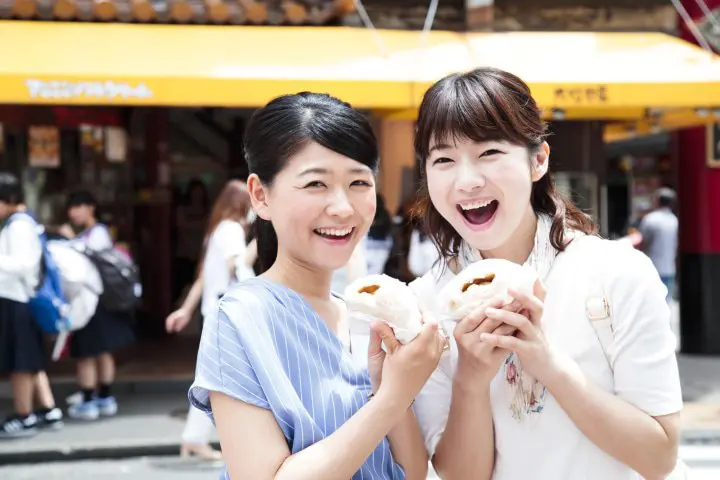
Photo by Pixta
You will notice many street-side vendors selling large steamed buns. It is hard to resist these aromatic and delicious steamed buns, all available at cheap prices. Filled with various ingredients, these massive and well-loved snacks abound the streets of Chinatown. We especially recommend the huge steamed pork buns, loaded with coarsely chopped pork, leeks, and tiny cubes of pickled mustard greens.
For those craving something sweet instead, try the red bean paste-filled anman buns, which also come in a variety of small and large sizes. These are often sold at the stands along with the pork buns. You will also find adorable panda-shaped buns at certain stands, usually containing red bean paste, chocolate, or pork.
Other common, must-try street food are sesame seed balls or goma dango, small fried balls covered in sesame seeds with a red bean filling inside. The sweetness of the red bean paste is delicious paired with the semi-sweet, savory flavors of the sesame and the fried dough.
Shoronpo, or juicy Chinese dumplings, are another popular street treat that has a savory meat-based filling. They are so delicious that you will want to try all the varieties!
Chinatown Egg Tarts
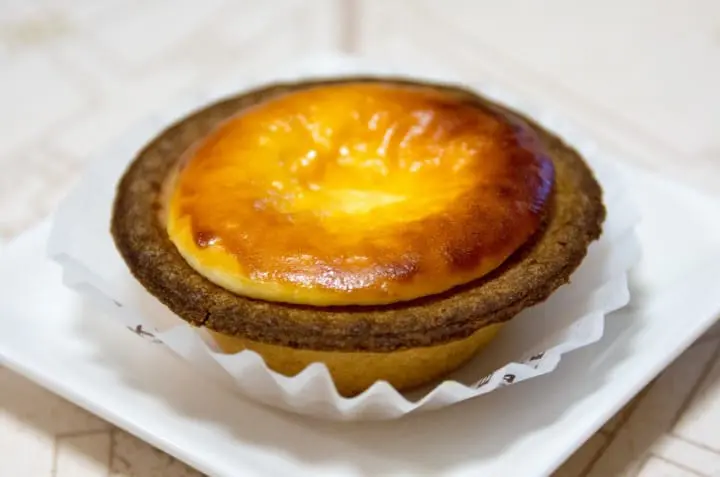
Egg tarts are a variety of custard tarts found in many parts of China and Taiwan. You will find vendors and shops selling these treats baked fresh in Yokohama. They have an irresistible sweetness balanced with a full egg flavor, and the texture of the crust is crumbly and melty.
Chinatown Roasted Chestnuts
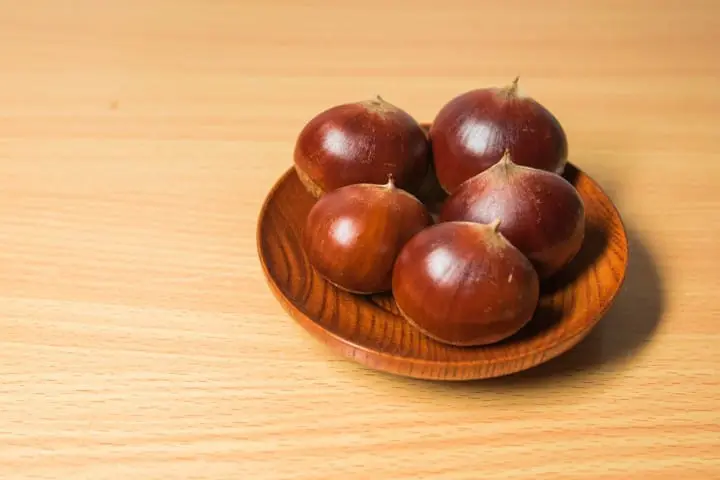
Another food item you will see being sold on the street corners are yaki-guri, or roasted chestnuts. Vendors may try to get you to purchase a bag by offering free samples at first. These slightly-sweet, healthy snacks are roasted on-the-spot, in front of you. They are particularly well-known in Yokohama's Chinatown.
5. Enjoy Some Fine Peking Duck
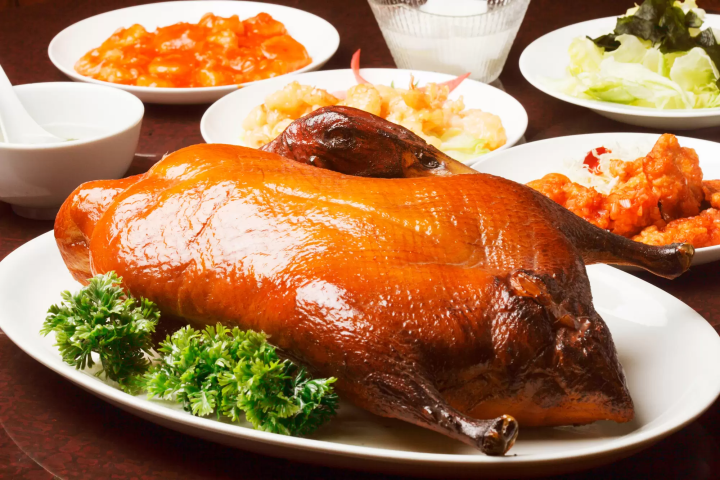
Photo by Pixta
In Yokohama Chinatown you'll find multiple places to enjoy some fine Peking duck.
• Jukeihanten (重慶飯店)
One of the most famous Chinese restaurants in all of Yokohama’s Chinatown, Jukeihanten is known for its high-quality Peking Duck and offers a wide range of authentic Chinese dishes. The staff there are accustomed to serving international guests, and the menu often has English translations, making it easy for international visitors to order.
• Heichinro (聘珍樓)
One of the oldest and most prestigious Chinese restaurants in Japan, Heichinro is famous for its exquisite Peking Duck and luxurious dining experience. The restaurant is well-known for accommodating English-speaking tourists with English menus and attentive staff.
• Shatenki (謝甜記)
Shatenki is a popular restaurant in Chinatown that serves delicious Peking Duck along with other traditional Chinese cuisine. They are known for being tourist-friendly, with English-speaking staff and menus available to help international guests navigate their meal choices.
6. Dine at All-You-Can Eat and High-End Chinese Restaurants
Chinatown is filled with restaurants offering all types of Chinese cuisine, all at different price points. Visitors will find all-you-can-eat restaurants and eateries specializing in fine dining options. Below is an introduction to some recommended dishes you should consider trying.
Chinatown Mapo Tofu
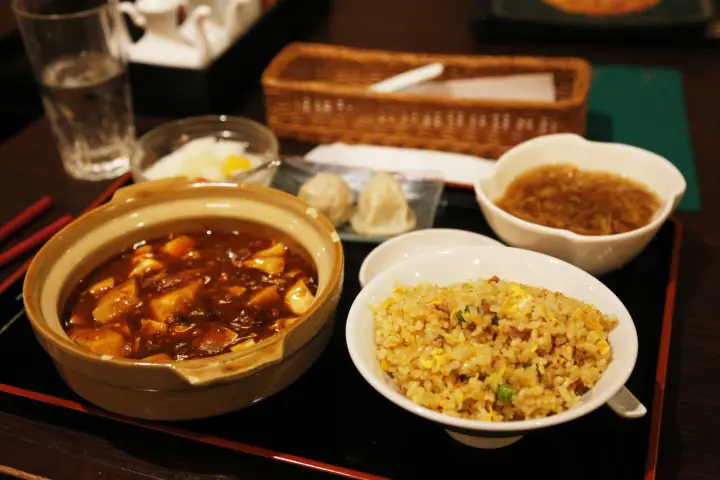
Photo by Pixta
Mapo tofu is another must-try dish from Chinatown. Originally a dish from the Sichuan province in China, it consists of tofu boiled in a spicy chili and red bean based sauce, cooked with fermented black beans and minced pork or beef. Variations are made with other ingredients that are popular in Japan.
Mapo tofu comes in a set meal and is usually affordable. Many restaurants have different prices for the same dish. You can choose from the array of restaurants as you walk along the streets of Chinatown. A picture of the menu and the prices of each dish are displayed on the boards outside the shops, so choosing what and where you want to eat won't be a difficult task.
Chinatown Dim Sum
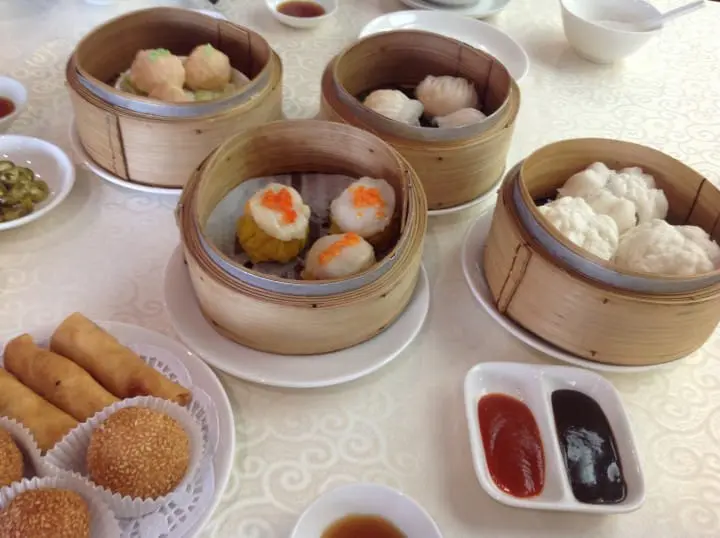
Dim sum, or yum cha, is a meal consisting of several small dishes. This is a type of traditional Chinese cuisine ideal for diners who want to try a little bit of everything. Numerous eateries in Chinatown offer yum cha and even all-you-can-eat options.
Chinatown Vegetarian and Vegan Options
Chinese food traditionally contains meat, fish, and many animal-based ingredients. However, there are vegetarian and vegan options on the menus of a few Taiwanese-style restaurants in Yokohama Chinatown. These places cook traditional, non-vegetarian fare, too, making them easy to visit with larger groups with different dietary preferences. Be sure to ask for the vegetarian or vegan menu, and specify what you can and cannot eat.
Banwarou is a cozy, casual Taiwanese restaurant located next to Kanteibyo Temple. The owner is very friendly and happy to accommodate vegetarians and vegans, so be sure to ask for the special vegan menu when you visit. We recommend visiting as a small group since the restaurant is not very big.
Koukien is another casual Taiwanese-style restaurant with a friendly staff offering a vegan/vegetarian menu , located in the heart of Chinatown. Remember to be clear when specifying your dietary needs.
For a more formal meal try Chojo Hanten, a famous Yokohama Chinese restaurant that serves vegan and vegetarian options. The food here is more expensive than the other two restaurants above but has an elegant atmosphere that's ideal for a special occasion. The restaurant is located next to the Choyo-mon, or the East Gate entrance.
7. Experience Traditional Chinese Tea
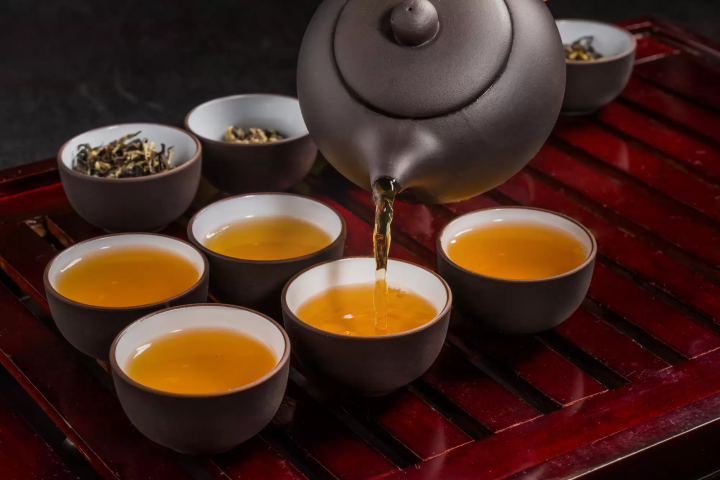
Photo by Pixta
There are many tea houses which provide an excellent opportunity to experience traditional Chinese tea culture in the heart of Yokohama's Chinatown.
1. Kanteibyo Chinese Tea House (關帝廟中国茶館)
Located near the famous Kanteibyo Temple, this tea house provides an authentic atmosphere to enjoy a variety of Chinese teas.
2. Rose Hotel Yokohama's Chinese Tea Room (ローズホテル横浜 中国茶室)
Situated within the Rose Hotel, this tea room offers a selection of fine Chinese teas in a relaxing environment.
3. Yokohama Daisekai's Tea Room (横浜大世界 中国茶室)
Inside the Yokohama Daisekai complex, this tea room offers a range of Chinese teas along with a serene setting perfect for tea tasting.
4. Jugetsudo (寿月堂 横浜店)
Known for its high-quality teas, Jugetsudo offers a variety of Chinese and Japanese teas in a peaceful setting.
5. Eikan Shinkan (永漢新館)
A well-known restaurant in Chinatown that also offers a selection of Chinese teas, perfect for those wanting to experience traditional tea culture alongside their meal.
8. Find Traditional Chinese Herbs and Medicines
Explore and experience traditional Chinese medicine while enjoying other activities in the vibrant neighborhood. Here are a couple popular recommend spots to visit.
1. Sato Chinese Medicine Pharmacy (佐藤中医薬局)
This pharmacy in Yokohama's Chinatown, offers a large range of traditional Chinese medicines and consultations.
2. Shuizeido (瑞穂堂薬局)
Shuizeido is a well-known Chinese herbal medicine shop, providing various herbal remedies and health products.
3. Shinminkan (神明館薬局)
Yokohama Chinatown's Shinminkan offers traditional Chinese herbs and medicinal products.
4. Fukumasa Yakkyoku (福万堂薬局)
Fukumasa Yakkyoku is a pharmacy that specializes in Chinese herbal medicines.
5. Yokohama Daisekai's Chinese Medicine Shop (横浜大世界 漢方薬局)
Situated in the Yokohama Daisekai complex, this shop offers a variety of Chinese medicinal products.
9. Shop for Chinatown Souvenirs
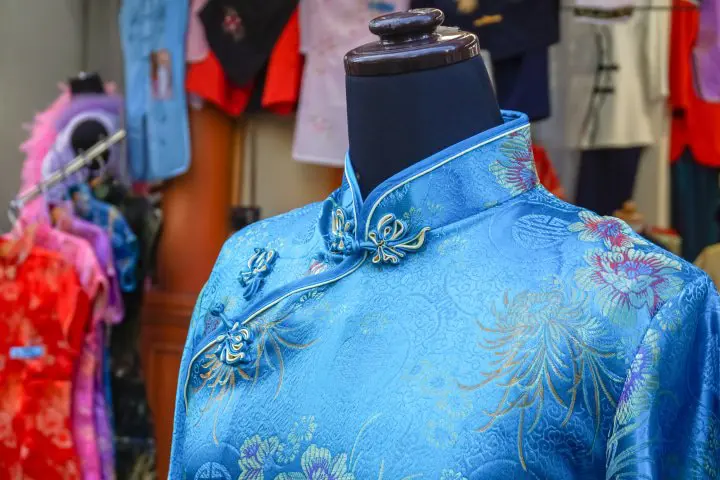
Photo by Pixta
Chinatown boasts a variety of shops selling Chinese vegetables, fruit, herbs, seasonings, and spices. In addition, one can find stores selling kitchen utensils, lanterns, and Chinese wines. The stalls of Chinese fortune tellers, palm readers, and astrology advisers are also a common sight on the streets in the area.
What to buy in China town in Yokohama
Yokohama's Chinatown offers a variety of unique and culturally rich items for tourists to purchase. Here are some popular souvenirs and items to buy in Chinatown:
1. Chinese Tea Sets: Explore the numerous shops selling traditional Chinese tea sets, including teapots, cups, and accessories, perfect for enjoying Chinese tea at home.
2. Chinese Traditional Clothing: Look for stores offering traditional Chinese garments such as qipao (cheongsam) or tangzhuang (male attire), beautifully designed and often made with intricate patterns and fabrics. Qipao can be very hard to find in other areas of Japan.
3. Chinese Calligraphy Artwork: Purchase calligraphy brushes, ink, and paper, as well as authentic Chinese calligraphy artworks featuring auspicious characters or famous quotes, adding a touch of elegance to your home decor.
4. Chinese Lanterns: Browse shops selling colorful and ornate Chinese lanterns, ranging from small handheld ones to larger decorative pieces, ideal for adding a festive atmosphere to any setting.
5. Chinese Fans: Consider buying decorative Chinese fans, which come in various designs and materials, from delicate silk hand fans to intricately carved wooden ones, both functional and stylish souvenirs.
6. Chinese Zodiac Items: Discover shops offering items related to the Chinese zodiac, such as figurines, keychains, or ornaments representing the twelve animals, a meaningful and symbolic souvenir.
7. Chinese Arts and Crafts: Seek out galleries or shops selling Chinese artworks and crafts, such as porcelain vases, jade sculptures, or embroidered silk art, showcasing the rich cultural heritage of China.
8. Feng Shui Items: Look for shops offering Feng Shui products, such as lucky charms, crystals, or statues, believed to bring harmony, prosperity, and good fortune to your home or workplace.
9. Cute Souvenirs: Many adorable panda-related items, from plush toys, to stationery, to socks, are sold in Yokohama Chinatown as well. There is also a Daiso with an entire inventory of fun, 100-yen items.
Yokohama Daisekai: Chinatown's Largest Multi-Entertainment Facility
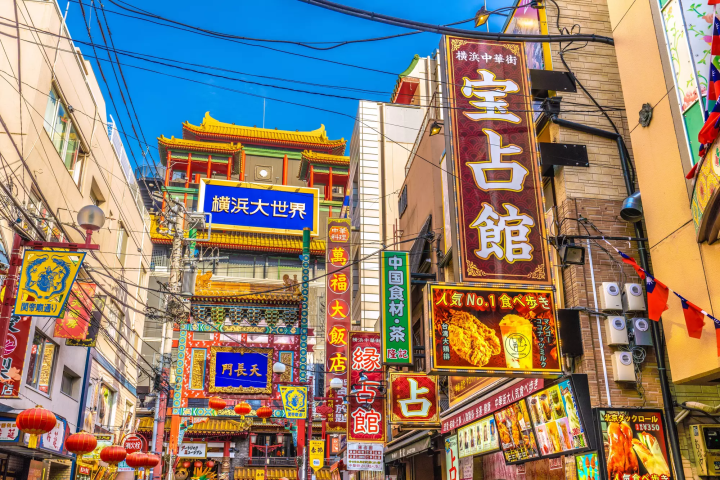
Photo by Pixta
Yokohama Daisekai (Japanese) is all about "playing, shopping, eating, and healing" as an all-in-one entertainment complex. There's so much to do, many people easily spend an entire day at Yokohama Daisekai! As a impressive tourist spot in Yokohama, many guests from all over the world come to enjoy some time in this facility.
10. Celebrate Chinese New Year
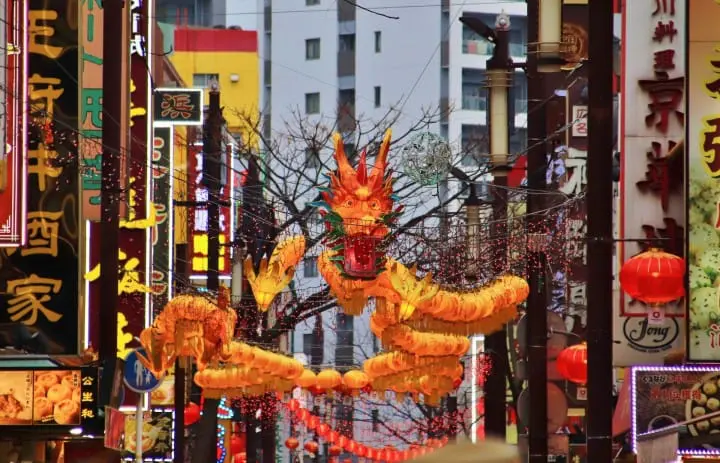
Yokohama Chinatown is renowned for its large-scale Chinese New Year Festival held annually between late January and mid-February. The streets of Chinatown are transformed with lanterns and other colorful decorations like Chinese dragons. There are also traditional performances and parades with participants in Chinese lion costumes.
Visiting during this season is a very festive, fun experience you won't want to miss out on.
Hotels in Yokohama Chinatown
Daiwa Roynet Hotel Yokohama-Koen
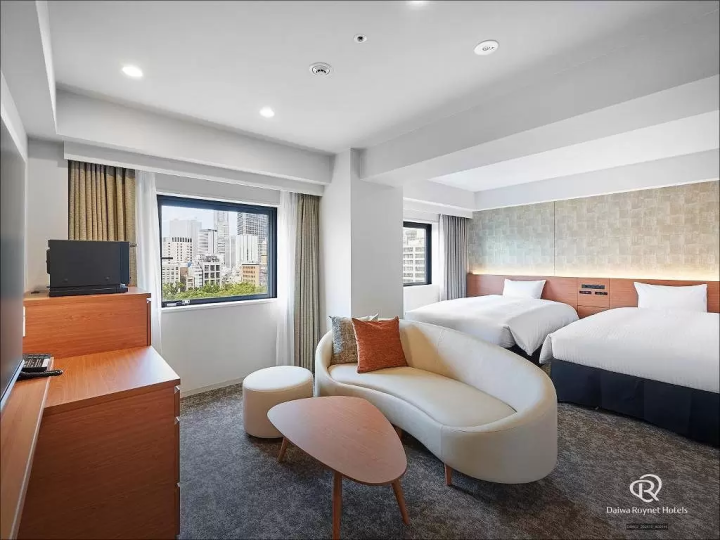
Photo courtesy of Booking.com
Daiwa Roynet Hotel Yokohama-Koen is conveniently located just a 5-minute walk from Chinatown, making it an ideal base for exploring this vibrant area. The hotel features a welcoming lobby with a bar and stone wall, along with comfortably designed rooms that include flat-screen TVs, refrigerators, and air conditioning. Guests can enjoy a delicious breakfast buffet at the on-site restaurant, Aquila Wallance. Additional amenities include free Wi-Fi, on-site parking, a coin laundry, and dry cleaning services. With its friendly staff and excellent location, the hotel offers a pleasant experience for both leisure and business travelers.
The Gate Hotel Yokohama by Hulic

Photo courtesy of Booking.com
The Gate Hotel Yokohama by Hulic is a sleek 4-star hotel nestled in the vibrant heart of Yokohama, just an 8-minute stroll from the lively Yokohama Chinatown. The hotel's interiors exude a chic and contemporary design, featuring stylish air-conditioned rooms that combine elegant furnishings with a warm, inviting ambiance. Guests can begin their day with a delightful à la carte breakfast at the beautifully designed restaurant, which offers a tempting selection of delicious Western-style dishes.
The atmospheric bar provides an equally stunning experience, serving as an elegant retreat for guests to relax and savor a curated selection of beverages. The shared lounge, complete with a terrace, boasts breathtaking views, making it an idyllic spot to unwind. With complimentary Wi-Fi, a 24-hour front desk, and accessible facilities, The Gate Hotel Yokohama is the perfect comfortable base for exploring nearby attractions, including the iconic Yokohama Marine Tower, just a 3-minute walk away.
Rose Hotel Yokohama
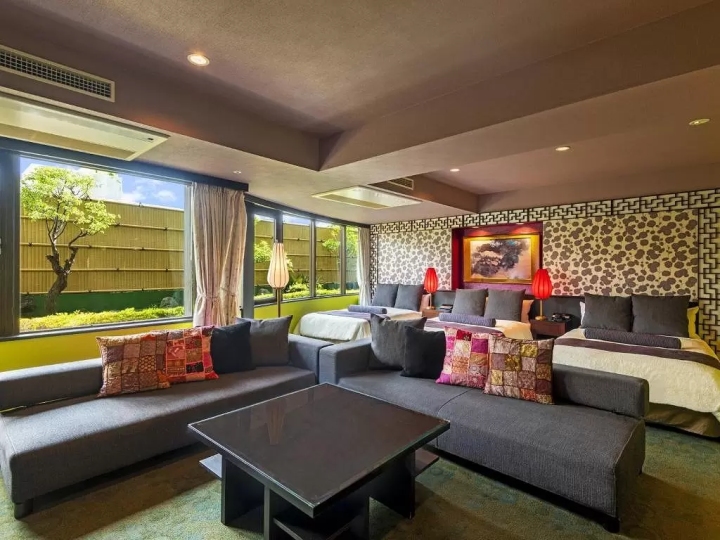
Photo courtesy of Booking.com
Rose Hotel Yokohama, The Distinctive Collection By WORLDHOTELS is an elegant 4-star hotel located just 5 minutes walks from Motomachi-Chukagai Subway Station and a 5-minute walk from vibrant Yokohama Chinatown. Blending classic charm with modern comfort, the hotel features spacious Western-style rooms, including the striking Dynasty Lounge—a private suite with a lounge area and an outdoor garden for serene views.
Guests can enjoy dining at the on-site French and Chinese restaurants, while the seasonal outdoor pool offers a refreshing retreat. With amenities like free Wi-Fi, a 24-hour front desk, and concierge services, Rose Hotel Yokohama is an ideal base for exploring nearby attractions, including Yamashita Park and Yokohama Stadium.
Access to Yokohama Chinatown
Yokohama Chinatown is located in the central part of Yokohama, near many popular areas, like Minato Mirai, Sakuragicho, and Motomachi. It is easily accessible from within Yokohama and also from Tokyo.
The closest station is Motomachi-Chukagai Station (Minato Mirai Line) or Ishikawacho Station (JR Negishi Line), which are both 7-8 minute-walks to the main entrance.
From Tokyo Station, the fastest way to get to Chinatown is to take the JR Tokaido Main Line (bound for Odawara) until Yokohama Station. At Yokohama Station transfer to the Negishi Line (bound for Ofuna or Isogo) and ride the train until Ishikawacho Station. In total it will take around one hour and 570 yen.
From Shibuya Station, you can reach Chinatown directly, without transferring trains. Ride the limited express train on the Tokyu Toyoko Line at Shibuya Station going to Motomachi-Chukagai. Get off at the last stop (Motomachi-Chukagai Station). The ride is about 45 minutes and costs 500 yen.
FAQ
Is 1 day in Yokohama enough?
Spending one day in Yokohama can provide a taste of the city's highlights and key attractions, allowing you to sample its diverse offerings. While one day allows you to explore some of Yokohama's notable landmarks like Chinatown, Minato Mirai waterfront district, and Yamashita Park, it may feel somewhat rushed if you aim to delve deeply into all the city has to offer. To make the most of a day in Yokohama, consider prioritizing specific attractions based on your interests, such as enjoying the bustling ambiance of Chinatown, taking in the modern urban landscape of Minato Mirai, or relaxing at picturesque waterfront spaces. While one day may not suffice to fully immerse yourself in all of Yokohama's facets, careful planning and focusing on selected highlights can still provide a memorable and enjoyable experience in this vibrant and culturally rich city.
What food is Yokohama known for?
Yokohama, a port city in Japan, boasts a rich culinary scene with a variety of distinctive foods. Renowned for its diverse offerings, Yokohama stands out for specialties like Sanma Men, a unique ramen featuring clear fish and chicken broth with grilled Pacific saury, Shumai dumplings packed with pork and shrimp, and Kamaboko fish cakes used in various dishes. The city's vibrant Chinatown showcases Chinese delights such as steamed buns and dim sum. Yokohama's love for curry rice, featuring a sweeter, thicker curry sauce, and its fresh seafood options like shioyaki and sashimi further add to its gastronomic appeal. Reflecting its multicultural heritage, Yokohama's food culture is a blend of traditional Japanese fare and international influences, making it a must-visit destination for food enthusiasts.
Is Chinatown in Yokohama worth visiting?
Yokohama's Chinatown is a must-visit destination, offering a vibrant cultural experience with its lively atmosphere, traditional Chinese architecture, and rich culinary scene. It stands out as one of the world's largest Chinatowns, providing a variety of authentic Chinese dishes like steamed buns, dumplings, and noodles. Visitors can explore shops selling Chinese tea, snacks, and unique souvenirs, making it a great place for shopping and cultural immersion. The area hosts festivals and events throughout the year, adding to its lively charm. With historical sites, temples, and its proximity to other Yokohama attractions, Chinatown in Yokohama presents a blend of heritage, flavors, and experiences that make it a rewarding and memorable destination for all visitors.
Which station for Yokohama Chinatown?
The closest station to Yokohama Chinatown is Motomachi-Chukagai Station (元町中華街駅). This station is located on the Minatomirai Line in Yokohama, Japan, and it provides convenient access to Yokohama's Chinatown district. From Motomachi-Chukagai Station, it is just a short walk to the entrance of Yokohama Chinatown, allowing visitors easy transportation to explore the vibrant streets, shops, and dining options in this popular area.
Is Yokohama Chinatown the biggest?
Yes, Yokohama Chinatown is the largest Chinatown in Japan and is one of the largest Chinatowns in the world. It covers a significant area in Yokohama, featuring a vibrant and bustling atmosphere with a wide variety of restaurants, shops, food stalls, and cultural attractions. The sheer size and diversity of offerings in Yokohama Chinatown make it a popular destination not only for locals but also for tourists looking to immerse themselves in Chinese culture, cuisine, and traditions.
Is Yokohama Chinatown the same as Kobe Chinatown?
Yokohama Chinatown and Kobe Chinatown, also known as Nankinmachi, are vibrant cultural hubs in Japan, each with its own unique appeal. Yokohama Chinatown stands out as the largest Chinatown in Japan and one of the largest globally, offering a bustling atmosphere, diverse culinary experiences, and a rich array of shops and eateries in a colorful setting. In contrast, Kobe's Nankinmachi, one of the oldest Chinatowns in Japan, boasts a historical charm with its compact size, traditional ambiance, and culinary specialties like steamed buns and dim sum. While both Chinatowns provide a taste of Chinese culture and cuisine, Yokohama impresses with its size and variety, while Kobe's Nankinmachi captivates with its history, architectural blend, and culinary delights, making each a destination worth exploring for those interested in Chinese heritage and gastronomy in Japan.
Experience the Best of Yokohama Chinatown
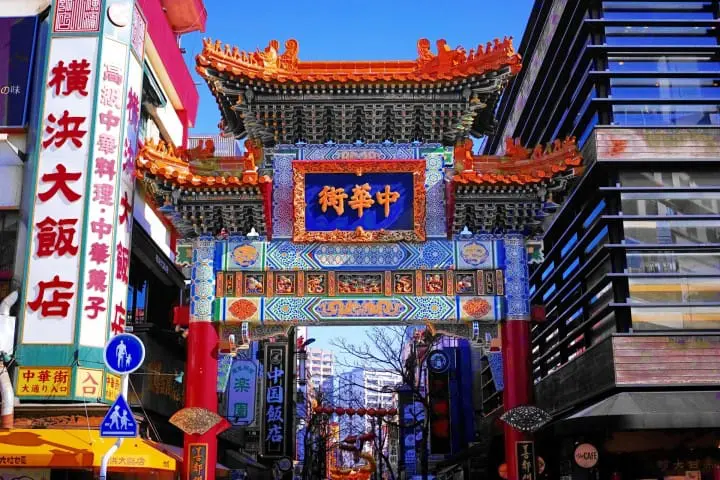
Yokohama Chinatown is a fascinating area that will allow you to feel as if you are traveling to Japan and China at the same time. It is a great destination for a peaceful afternoon or evening and symbolizes the multicultural appeal of Yokohama.
Main image by Pixta
This account is managed by MATCHA. We aim to provide useful information to our readers in an enjoyable manner.







































![[Coupon Available] Attention Overseas Winter Sports Fans! Nagano's Sports Depot Has Evolved](https://resources.matcha-jp.com/resize/720x2000/2026/01/05-254819.webp)
![[2 hours from Tokyo ] 10 Quiet and Breathtaking Views of Mount Fuji in Yamanashi Hokuto City , Yamanashi - Part 2](https://resources.matcha-jp.com/resize/720x2000/2025/12/16-253037.webp)

![[Reopening in March 2026] Ikoma Sanjo Amusement Park Park, 45 minutes from Osaka , with free admission](https://resources.matcha-jp.com/resize/720x2000/2024/08/28-194409.webp)